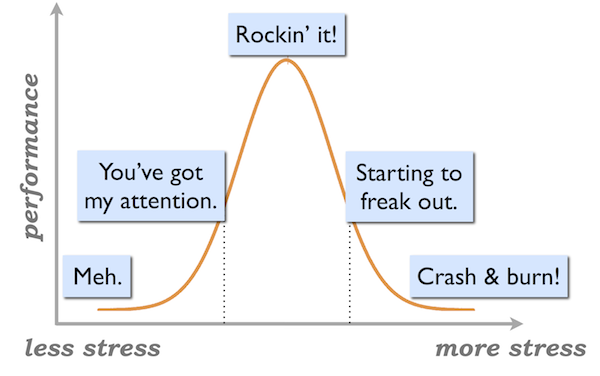In a Nutshell
- Stress isn’t “bad.” Stress is your body’s response to challenges. While excessive, unrelenting stress can be detrimental, a certain amount can be beneficial, driving growth and performance.
- Identify your stress ‘sweet spot.’ Optimal stress levels vary for each individual. Finding the right balance—where stress motivates without overwhelming—is key to growth and well-being.
- Perception matters. How you perceive stressors influences their impact. Viewing challenges as opportunities rather than threats can transform stress into a positive force.
- Recovery is essential. Just as important as managing stress is allowing time for recovery. Regular rest and relaxation help maintain resilience and prevent burnout.
- Balance is dynamic. Life’s demands fluctuate, so regularly reassessing and adjusting your stress levels ensures you stay within your “optimal” zone.
The same exact stressors—job pressure, kids, money, and, yes, an intense exercise and eating regimen—can energize and inspire you or sap your will and your mojo. Reaching your potential is about finding your stress sweet spot and using it to propel you to your goals. Here’s how.
++++
It’s a well-known fact: Being stressed out can make it really hard to reach your health and fitness goals.
But did you know: Not having enough stress can slow your progress too?
See, stress isn’t a “thing” that happens to you. Stress is your response to the challenges you face every day.
These stressors — like pressure at your job, raising kids, managing money, piles of dirty laundry, and, yes, nutrition and exercise — can make you either puff out your chest and get ‘er done like Super(wo)man, or crumble and sink into your couch like a dry, bland sugar cookie.
The key is to find your “stress sweet spot” — just enough stress, but not too much — so you can reach your potential without crashing and burning.
In this infographic, we explain the importance of balancing your allostatic (stress) load, and exactly how to do it so you can feel and perform your best.
Download the infographic for your printer or tablet so you can access these tips whenever you feel either under- or overwhelmed.
To put these stress-balancing strategies into regular practice, download a printable or tablet-friendly version of this infographic so it’s always handy.
And, if you’re a health and fitness coach, share this with your clients and watch for improvements in their motivation, dedication, and results.
For an even more comprehensive take on this topic, check out our accompanying article, Good stress, bad stress: Finding your sweet spot.
If you’re a health and fitness coach…
Learning how to help clients manage stress, build resilience, and optimize sleep and recovery can be deeply transformative—for both of you.
It helps clients get “unstuck” and makes everything else easier—whether they want to eat better, move more, lose weight, or reclaim their health.
And for coaches: It gives you a rarified skill that will set you apart as an elite change maker.
The brand-new PN Level 1 Sleep, Stress Management, and Recovery Coaching Certification will show you how.
Want to know more?




Share